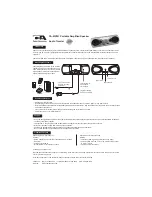
Operator’s Manual for Power Washer
15
Prepare Fuel System for Storage
Fuel stored over 30 days can go bad and
damage fuel system components. Keep fuel
fresh, use fuel stabilizer.
If fuel stabilizer is added to fuel system, pre-
pare and run engine and pump for long term
storage. Run engine for 2 minutes to circulate
stabilizer throughout fuel system. Adequately
prepared fuel can be stored up to 24 months.
NOTE: If fuel has not been treated with fuel
stabilizer, it must be drained into an approved
container. Run engine until it stops from lack
of fuel. Use of fuel stabilizer in fuel storage
container is recommended to keep fuel fresh.
Prepare Engine for Storage
1.
Change engine oil.
2.
Remove spark plug.
3.
Pour tablespoon (5-10cc) of clean
engine oil or spray a suitable fogging
agent into cylinder.
4.
Pull starter recoil several times to dis-
tribute oil in cylinder.
5.
Install spark plug.
6.
Pull recoil slowly until resistance is
felt. This will close valves so moisture
cannot enter engine cylinder. Gently
release recoil.
Change Oil
Change engine oil before storage. See, sub-
Prepare Pump for Storage
Protect unit from freezing temperatures. Fail-
ure to do so will permanently damage pump
and render unit inoperable. Freeze damage is
not covered under warranty.
Protect unit from freezing temperatures as fol-
lows:
1.
Shut engine OFF.
2.
Turn water supply OFF.
3.
Point spray gun in a safe direction,
and squeeze trigger to relieve trapped
pressure.
4.
Let engine cool.
5.
Disconnect hoses from spray gun and
high-pressure outlet on pump. Drain
water from hoses, spray gun, and
lance. Use a rag to wipe off compo-
nents.
6.
Empty pump of all remaining liquids.
7.
Turn engine start switch and fuel
valve to OFF.
8.
Pull recoil handle approximately six
times to remove remaining liquid from
pump.
9.
Winterize pump with pump saver. This
minimizes freeze damage and lubri-
cates pistons and seals.
NOTE
: If pump saver is not available, connect
a 3-foot section of garden hose to water inlet
adapter. Pour RV-antifreeze (antifreeze with-
out alcohol) into hose. Pull recoil handle twice.
Disconnect 3-foot hose.
Store unit in a clean and dry area.
Table 1: Troubleshooting
Problem
Cause
Correction
Pump fails to produce pressure, has
erratic pressure, chattering, loss of
pressure, low water volume.
1. Low pressure nozzle installed.
2. Water inlet is obstructed.
3. Inadequate water supply.
4. Inlet hose kinked or leaking.
5. Clogged hose inlet screen.
6. Water supply is over 100 ºF (37.8
ºC).
7. High-pressure hose is obstructed, or
leaks.
8. Spray gun leaks.
9. Nozzle is obstructed.
10. Pump is faulty.
1. Replace with high-pressure nozzle.
2. Clean inlet.
3. Provide adequate water flow.
4. Straighten inlet hose, patch leak.
5. Inspect and clean inlet hose screen.
6. Provide cooler water supply.
7. Clear obstructions or replace hose.
8. Replace spray gun.
9. Clean nozzle.
10. Contact authorized servicing dealer.
Detergent fails to mix with spray.
1. Detergent siphoning tube is not sub-
merged.
2. Detergent siphoning tube/filter is
obstructed or cracked.
3. High-pressure nozzle installed.
1. Insert detergent siphoning tube into
detergent.
2. Clean or replace filter/detergent
siphoning tube.
3. Install low-pressure nozzle.
Engine runs well at no-load, but bogs
when load is applied.
1. Engine speed too low.
1. Contact authorized servicing dealer.
Engine will not start, or starts and runs
rough.
1. Dirty air filter.
2. Out of fuel
3. Stale fuel.
4. Spark plug wire not connected to
plug.
5. Bad spark plug.
6. Water in fuel.
7. Excessively rich fuel mixture.
1. Clean or replace air filter.
2. Fill fuel tank.
3. Replace with fresh fuel.
4. Connect wire to spark plug.
5.Replace spark plug.
6. Drain fuel tank, replace with fresh
fuel.
7. Contact authorized servicing dealer
Engine shuts down during operation/
1. Out of fuel.
1. Fill fuel tank.
Engine lacks power.
1. Dirty air filter.
1. Replace air filter.
















































